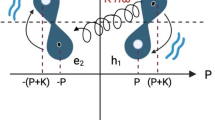Abstract
Reversing the loop lengths of the small protein S6 by circular permutation has a dramatic effect on the transition state structure: it changes from globally diffuse to locally condensed. The phenomenon arises from a biased dispersion of the contact energies. Stability data derived from point mutations throughout the S6 structure show that interactions between residues that are far apart in sequence are stronger than those that are close. This entropy compensation drives all parts of the protein to fold simultaneously and produces the diffuse transition-state structure typical for two-state proteins. In the circular permutant, where strong contacts and short sequence separations are engineered to concur, the transition state becomes atypically condensed and polarized. Taken together with earlier findings that S6 may also fold by a 'collapsed' trajectory with an intermediate, the results suggest that this protein may fold by a multiplicity of mechanisms. The observations indicate that the diffuse transition state of S6 is not required for folding but could be an evolutionary development to optimize cooperativity.
This is a preview of subscription content, access via your institution
Access options
Subscribe to this journal
Receive 12 print issues and online access
$189.00 per year
only $15.75 per issue
Buy this article
- Purchase on Springer Link
- Instant access to full article PDF
Prices may be subject to local taxes which are calculated during checkout




Similar content being viewed by others
References
Jackson, S.E. Folding Des. 3, R81–91 (1998).
Fersht, A.R. Structure and Mechanism in Protein Science: A Guide to Enzyme Catalysis and Protein Folding (W.H. Freeman, New York; 1999).
Itzhaki, L.S., Otzen, D.E. & Fersht, A.R. J. Mol. Biol. 254, 260–288 (1995).
Ternstrom, T., Mayor, U., Akke, M. & Oliveberg, M. Proc. Natl. Acad. Sci. USA 96, 14854–14859 (1999).
Fersht, A.R. Proc. Natl. Acad. Sci. USA 92, 10869–10873 (1995).
Grantcharova, V.P., Riddle, D.S., Santiago, J.V. & Baker, D. Nature Struct. Biol. 5, 714–720 (1998).
McCallister, E.L., Alm, E. & Baker, D. Nature Struct. Biol. 7, 669–673 (2000).
Martinez, J.C., Pisabarro, M.T. & Serrano, L. Nature Struct. Biol. 5, 721–729 (1998).
Plaxco, K.W., Simons, K.T. & Baker, D. J. Mol. Biol. 277, 985–994 (1998).
Lindberg, M.O. et al. J. Mol. Biol. 314, 891–900 (2001).
Lindahl, M. et al. EMBO J. 13, 1249–1254 (1994).
Otzen, D.E. & Oliveberg, M. J. Mol. Biol. 317, 613–627 (2002).
Flory, P.J. J. Am. Chem. Soc. 78, 5222–5235 (1956).
Villegas, V., Martinez, J.C., Aviles, F.X. & Serrano, L. J. Mol. Biol. 283, 1027–1036 (1998).
Kragelund, B.B. et al. Nature Struct. Biol. 6, 594–601 (1999).
Choe, S.E., Li, L., Matsudaira, P.T., Wagner, G. & Shakhnovich, E.I. J. Mol. Biol. 304, 99–115 (2000).
Chakravarty, S. & Varadarajan, R. Structure Fold. Des. 7, 723–732 (1999).
Doyle, R., Simons, K., Qian, H. & Baker, D. Proteins 29, 282–291 (1997).
Otzen, D.E. & Fersht, A.R. Biochemistry 37, 8139–8146 (1998).
Viguera, A.R., Serrano, L. & Wilmanns, M. Nature Struct. Biol. 3, 874–880 (1996).
Li, L. & Shakhnovich, E.I. J. Mol. Biol. 306, 121–132 (2001).
Wolynes, P.G. Proc. Natl. Acad. Sci. USA 93, 14249–14255 (1996).
Thirumalai, D. & Klimov, D.K. Folding Des. 3, R112–118 (1998).
Nauli, S., Kuhlman, B. & Baker, D. Nature Struct. Biol. 8, 602–605 (2001).
Plotkin, S.S. & Onuchic, J.N. Proc. Natl. Acad. Sci. USA 97, 6509–6514 (2000).
Shea, J.E., Onuchic, J.N. & Brooks, C.L. III J. Chem. Phys. 113, 7663–7671 (2000).
Otzen, D.E. & Oliveberg, M. Proc. Natl. Acad. Sci. USA 96, 11746–11751 (1999).
Canet, D. et al. Nature Struct. Biol. 9, 308–315 (2002).
McParland, V.J., Kalverda, A.P., Homans, S.W. & Radford, S.E. Nature Struct. Biol. 9, 326–331 (2002).
Agalarov, S.C., Sridhar Prasad, G., Funke, P.M., Stout, C.D. & Williamson, J.R. Science 288, 107–113 (2000).
Abkevich, V.I., Gutin, A.M. & Shakhnovich, E.I. J. Mol. Biol. 252, 460–471 (1995).
Koradi, R., Billeter, M. & Wüthrich, K. J. Mol. Graph. 14, 51–55 (1996).
Acknowledgements
We thank S. Plotkin, P. Wolynes and D. Thirumalai for stimulating discussions and Katarina Wallgren for technical assistance. The work was supported by the Swedish Research Council.
Author information
Authors and Affiliations
Corresponding author
Ethics declarations
Competing interests
The authors declare no competing financial interests.
Rights and permissions
About this article
Cite this article
Lindberg, M., Tångrot, J. & Oliveberg, M. Complete change of the protein folding transition state upon circular permutation. Nat Struct Mol Biol 9, 818–822 (2002). https://doi.org/10.1038/nsb847
Received:
Accepted:
Published:
Issue Date:
DOI: https://doi.org/10.1038/nsb847
This article is cited by
-
Circular permutation at azurin’s active site slows down its folding
JBIC Journal of Biological Inorganic Chemistry (2023)



